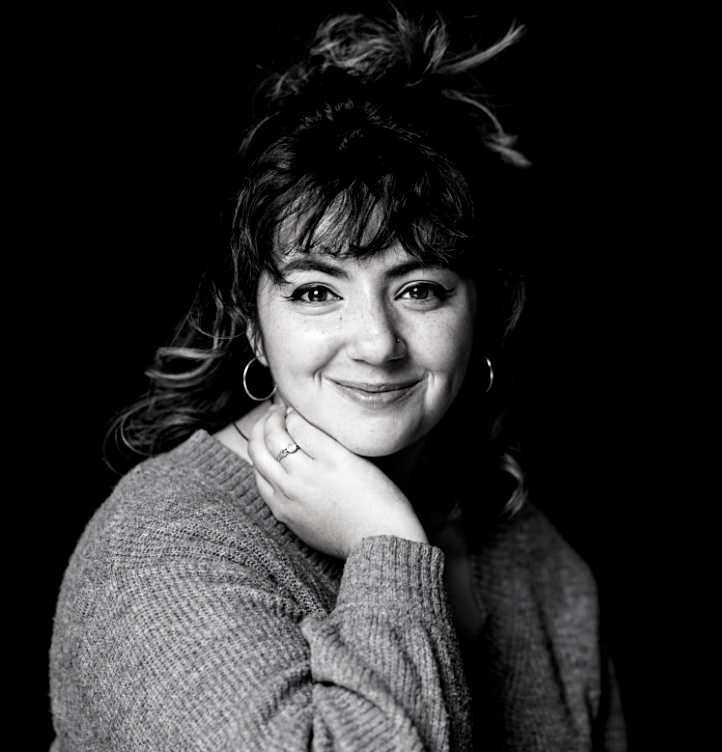Embedded Criticism: Transcending Time and Space in Theatre Passe Muraille’s Toka
Let’s time-travel.
It’s November 12, 2021. The return of in-person theatre as once we knew it is still a few months away. Stores along Queen Street West are still intermittently closed. A fifth wave of COVID-19 is on its way. Snow’s falling.
Intermission’s not yet announced its return to theatre criticism, but long conversations on the subject have been happening over Zoom. The topic of “embedded criticism” — the halfway point between dramaturgy and theatre reviewing, some might say, or the practical mediator between art and its audience — has come up frequently. Toronto landmark Theatre Passe Muraille has expressed interest in the idea: no surprise, given the institution’s track record of working to re-frame, re-position, and re-imagine existing customs and traditions in Canadian theatre.
It’s the penultimate day of filming at Theatre Passe Muraille for Toka, Indrit Kasapi’s haunting play about a post-Communist Albanian blood feud and the land upon which it unfolds. Toka is being filmed on a sprawling raked stage which occupies most of the Mainspace. A film crew of theatre people buzzes around the space, moving microphones, testing camera angles, pumping a truly immense amount of theatrical haze into the room — in this moment, Theatre Passe Muraille feels sacred, exciting. A theatre block becomes a tripod. A wardrobe assistant and ASM debate the innate goodness of apple cider versus juice — an extremely important wintertime debate. An actor studies a script.
I meet Marjorie Chan, Artistic Director of Theatre Passe Muraille, and Indrit Kasapi, Interim Managing Director and the playwright and choreographer behind Toka. He’s also just stepped in as a performer in the piece. We grab chairs and sit in the TPM balcony as the crew downstairs prepares for a long day of filming.
I have to be deliberate in engaging with the art.
Kasapi, though a little sleep-deprived (he’s been in his Interim MD position for about a week while also supervising and acting in Toka), is in high spirits.
“We’re in a good place. I’m feeling good about it.”
Chan, too. She’s spent the past twenty months reflecting on theatre’s shifting roles and possibilities, and she’s excited about Toka’s production after being postponed thrice due to the pandemic.
“I have to be deliberate in engaging with the art,” says Chan. “Nowadays, that’s happening at night, when I’m really giving myself the space to reflect on the art itself, not the paperwork or the planning.”
She speaks of her daily routine as an artistic director with no in-person theatre: “every day is always completely different. You wonder, do you come back to normality, or can it be something different? We’re able to adapt and change, and that’s what makes us different as a company — we have that flexibility.”
As if on cue, something crashes downstairs — a light stand.
Such is the hybridization of theatre and film.
What is this aesthetic that uses the form of film but that’s theatrical in its context?
“What is this aesthetic that uses the form of film but that’s theatrical in its context?,” wonders Kasapi aloud. “We’re not inventing it. This has existed for a while. But how are we confronting that form? How do we engage people in a live way?”
Chan nods emphatically. “We’re filming close-ups, different angles, different framings. There’s a more atmospheric context. Film lets us get intimate in a way that’s not necessarily costful to the experience of performance — it’s often much more effective.”
Time-travel back to today, April 20, 2022.
Toka premieres digitally tonight, and you, time-traveller, finally get to see the results of what we witnessed that snowy day in November.
The piece is unsettling; troubling; chasmous. Toka, a physical theatre creation, centres around a single blood feud but extrapolates to land disputes all over the world.
“Land ownership isn’t only an issue on Turtle Island. It’s everywhere, and everywhere the loss of land is devastating. Toka is about the blood feud, but it’s also about the land,” said Kasapi late last year. It’s completely true, and that universality tracks throughout the piece — though set in post-Communist Albania, the pain of intergenerational conflict feels just as potent here and now.
“This isn’t about Albania five hundred years ago,” agreed Chan in November. “It’s about Albania, like, twenty years ago. That’s nothing. We’re still reckoning. We’re still trying to reconcile with that.”
Toka’s set creates a space which matches its emotional heft.
In simple, contemporary costumes by Rachel Forbes (which occasionally featured long skirts worn with Blundstones, a Toronto-ism which subtly brought the piece closer to home for Theatre Passe Muraille), the cast of Toka wrestled with dance, fight choreography, singing, and high-energy, high-stakes moments of drama, all on a spectacularly raked stage.
When I first entered the TPM space last year, I was blown away by the stage’s incline — actors didn’t have to mime traversing the mountainous topography of Albania. They really did seem to scale hills, battle gravity, war with circumstance: in a set designed by Andjelija Djuric, who oversaw filming from over Zoom the day I was there, the futility of post-Communist blood feud was made literal. It’s a space which matched Toka’s subject matter and emotional heft, spackled with black and red paint and climbing all the way up to the TPM balcony.
Sitting in on a Toka filming day was unlike any open rehearsal I’d experienced before: there were laptops perched on every available chair, connected by snaking cables and important-looking headphones. Editor and cinematographer Kejd Kuqo even invited me to listen to the live feed on the monitor — I did, and the scrapes and chaos of the space around us dissipated into near-silence. Movie magic. In a moment between scenes, too, Kuqo asked what I thought.
“I mean, it’s just cool to be here! It’s incredible,” I said at the time.
“That’s not thoughts,” he teased with a smile, before directing his gaze back to the laptop before him.
Thoughts have had months to percolate, and having now seen the Toka which will be unveiled to the world tonight, those thoughts are more concrete: Toka is an enormous accomplishment in theatre-making. For its digital presentation, it’s lost none of its in-person resonance, its visceral fullness. Kasapi’s authorial vision, articulated to me in our interview, shines through in the piece: he told me the play was about “investigating how we move on and how we forgive.” He didn’t know if the play answered those questions, “but it certainly asks them.”
And it certainly does.
It’s not about vengeance, but about giving space for healing.
Toka’s streaming digitally, with captions available both in English and in Albanian. That’s an impressive accessibility measure (the script needed a full translation into Albanian) and it’s an important offering for both Kasapi and Chan, one which folds into Theatre Passe Muraille’s history of and commitment to ease of access for as many audiences as possible.
“We’ve always wanted to invite as many people into the space as possible,” said Chan in November. “If someone can’t afford a ticket, whatever, it’s a single comp, and they get to see the show. That’s huge. We want to be able to provide that one last accessibility measure that gets someone in a theatre and into the art.” To be sure, the offering of a relaxed digital presentation available in both English and Albanian is an accessibility measure for an otherwise underrepresented audience: viewers from around the world will be able to watch and enjoy Toka.
Toka’s subject matter may seem grim: it is. But the play isn’t all violence, isn’t all bloodshed.
“It’s not about vengeance, but about giving space for healing,” said Chan all those months ago.
And in a final, heartbreaking, gorgeous tableau, that healing is made physical: feuding families share grief, share stories, and share land. And even in a digital offering, that catharsis comes through loud and clear, transcending the limits of time and space.
Toka is being presented digitally by Theatre Passe Muraille. You can find out more about the production here.















Comments